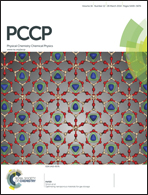Dissociative adsorption of 2,3,7,8-TCDD on the surfaces of typical metal oxides: a first-principles density functional theory study†
Abstract
The initial dissociative adsorption step of the 2,3,7,8-tetrachlorodibenzo-p-dioxin (2,3,7,8-TCDD) molecule on the surfaces of MgO, CaO, and CuO has been studied by density functional theory (DFT) using periodic slab models. It is found that the 2,3,7,8-TCDD molecule undergoes a similar dissociative adsorption step during the decomposition over the three metal oxide surfaces. The adsorption configuration of 2,3,7,8-TCDD first converts from a parallel mode into a vertical one, then a nucleophilic substitution process takes place, where the surface oxygen atom attacks the aromatic carbon to form a surface phenolate with the chlorine atom moving to the top of the nearest surface metal atom. The calculated apparent activation energy of the dissociation increases in the order of CuO < CaO < MgO. The reaction heat is −0.67 eV, −0.75 eV, and 0.45 eV for CuO, CaO, and MgO, respectively, suggesting the thermodynamic tendency of MgO < CuO < CaO, which parallels the trend of the nucleophilicity of surface oxygen atoms. This study suggests that metal oxides with more nucleophilic and less tightly-bonded surface oxygen atoms might be more promising for the decomposition of polychlorinated dibenzo-p-dioxins and dibenzofurans.


 Please wait while we load your content...
Please wait while we load your content...